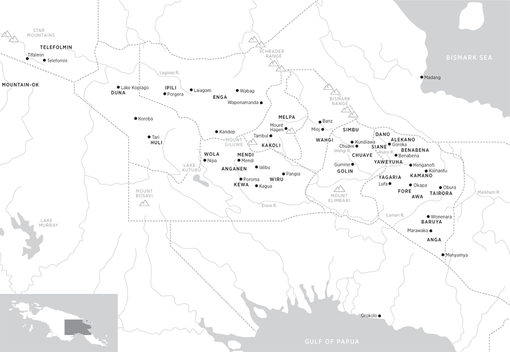Introduction

Map of the New Guinea highlands showing provinces, key locations and cultural groups. Click on the map for a larger version
Papua New Guinea’s spectacular highlands are home to more than one million people whose ancestors settled there around 50,000 years ago. With the introduction of fast-growing sweet potato in the 17th century, populations swelled dramatically and moved across the entire region. Geographical barriers and warfare isolated ethnic groups, resulting in remarkably varied cultural and social practices. This exhibition focuses on the extraordinary array of art forms that arose from this diversity.
The highlanders were unknown to the outside world until 1930, when Australian gold prospectors revealed vast populations living in the mountainous interior. Following the Second World War, the region became a magnet for anthropologists, missionaries and tribal art enthusiasts.
Sydney collector Stanley Moriarty first travelled to the highlands in 1961 and spent over a decade in the former Australian administered territories assembling a world-renowned collection of highlands art. Many of these artworks were acquired by the Art Gallery of NSW between 1968 and 1979.
Materials from the natural world are employed in creative and meaningful ways in all these works, reflecting a deep understanding of and reverence for the environment. Iridescent gold-lipped pearlshells, plumes from hundreds of species of birds, wood, bone, stone, fur, natural pigments and plant fibres of every kind are transfigured into objects of astonishing beauty. The appropriation of non-traditional, man-made materials similarly reveals the inventiveness of highlands artists, who continue to create today as they have done for countless generations.
Questions and activities
- Locate Papua New Guinea on a map and research its environment, eco-systems, flora and fauna. Investigate how natural resources and materials have been used by artists in the highlands. List the different ones you can see in the artworks in this exhibition.
- Imagine you are an Australian gold prospector in the 1930s travelling to the highlands of New Guinea when you encounter the people of the area for the first time. Write a diary entry of your first contact. Research real accounts after you have written your own and see if your account reflects the reality of events in the 1930s.
- Do you think it is possible to create art today without any outside influences? Experiment in your own art practice to see if you can create an artwork in isolation. What do you notice? What are the challenges? Discuss with your class.
- What are the challenges of conserving museum objects that are made from natural materials? Read the blog post by Gallery conservator Kerry Head to inform your discussion.
- Is it necessary for us to know everything about an object and its purpose for us to appreciate its artistic qualities? How important do you think it is for you to understand the cultural significance of these objects to the communities from which they came? What part can a gallery play in developing deeper understanding and meaning-making in relation to works of art?